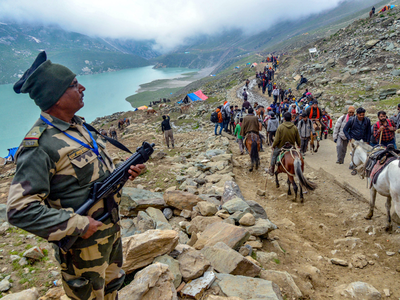- News
- India News
- Learning with the Times: How government regulates religious pilgrimages
Trending
This story is from July 16, 2018
Learning with the Times: How government regulates religious pilgrimages

In this file photo, security personnel look on as pilgrims make their way towards the holy cave shrine of Amarnath. (PTI)
Key Highlights
The annual Amarnath pilgrimage is inarguably a tough expedition in the best of conditions. This year’s pilgrimage has seen its share of casualties and a temporary halt to pilgrims’ movement. A look at how government regulates the Amarnath trek and other pilgrimages:
Why does government regulate the Amarnath Yatra?
Before 2000, there wasn’t much government intervention in the yatra. A heavy downpour in 1996 resulted in the death of about 250 yatris. Subsequently, the Nitish Sengupta Committee was set up to enquire into the deaths.
After it was decided that the government should intervene, the J&K Shri Amarnath Ji Shrine Act 2000 was passed that provided for the setting up of a board to manage the yatra.The Act states that the 10-member board is to be headed by the governor of J&K if he is a Hindu. A non-Hindu governor is supposed to nominate an eminent Hindu from the state to head the board, which also has government officials on deputation as its members.

The Haj pilgrimage works on a quota basis. Saudi authorities usually allocate 1,000 places for every million Muslim persons per country. As a result, the overwhelming majority of Haj berths go to Indonesia, Pakistan, India and Bangladesh. The Haj Committee of India regulates the state-wise quota based on the state’s Muslim population. Until last year, Haj was subsidised by the Centre with discounts on Air India flights and other forms of assistance provided. From this year, the subsidy has been discontinued.

How is the Kailash Mansarovar Yatra organised?
For this yatra, 18 batches of 60 pilgrims take the Lipulekh Pass route (at the border of Uttarakhand and Tibet). A further 10 batches of 50 pilgrims each take the Nathu La route (at the border between Sikkim and Tibet). The pilgrims’ list is finalised in a computerised draw. Government appoints liaison officers for each batch to coordinate with Indian and Chinese authorities. The Indo-Tibetan Border Police provides security, medical assistance to the yatris.
Does the Centre subsidise the Kailash Mansoravar and Amarnath yatras?
According to a parliamentary question, government of India does not extend any direct monetary subsidy to individual pilgrims for the Amarnath and Kailash Manasarovar yatras. But the foreign ministry assists, on a self-financing basis, pilgrims for the Kailash Manasarovar Yatra by providing facilities like transportation, accommodation, food, medical tests, guides, etc. News reports also state that the Kailash Mansoravar yatra is subsidised by some state governments.
Before 2000, there wasn’t much government intervention in the yatra. A heavy downpour in 1996 resulted in the death of about 250 yatris. Subsequently, the Nitish Sengupta Committee was set up to enquire into the deaths.
After it was decided that the government should intervene, the J&K Shri Amarnath Ji Shrine Act 2000 was passed that provided for the setting up of a board to manage the yatra.The Act states that the 10-member board is to be headed by the governor of J&K if he is a Hindu. A non-Hindu governor is supposed to nominate an eminent Hindu from the state to head the board, which also has government officials on deputation as its members.

How is the Haj pilgrimage regulated?
The Haj pilgrimage works on a quota basis. Saudi authorities usually allocate 1,000 places for every million Muslim persons per country. As a result, the overwhelming majority of Haj berths go to Indonesia, Pakistan, India and Bangladesh. The Haj Committee of India regulates the state-wise quota based on the state’s Muslim population. Until last year, Haj was subsidised by the Centre with discounts on Air India flights and other forms of assistance provided. From this year, the subsidy has been discontinued.

How is the Kailash Mansarovar Yatra organised?
For this yatra, 18 batches of 60 pilgrims take the Lipulekh Pass route (at the border of Uttarakhand and Tibet). A further 10 batches of 50 pilgrims each take the Nathu La route (at the border between Sikkim and Tibet). The pilgrims’ list is finalised in a computerised draw. Government appoints liaison officers for each batch to coordinate with Indian and Chinese authorities. The Indo-Tibetan Border Police provides security, medical assistance to the yatris.
Does the Centre subsidise the Kailash Mansoravar and Amarnath yatras?
According to a parliamentary question, government of India does not extend any direct monetary subsidy to individual pilgrims for the Amarnath and Kailash Manasarovar yatras. But the foreign ministry assists, on a self-financing basis, pilgrims for the Kailash Manasarovar Yatra by providing facilities like transportation, accommodation, food, medical tests, guides, etc. News reports also state that the Kailash Mansoravar yatra is subsidised by some state governments.
End of Article
FOLLOW US ON SOCIAL MEDIA










